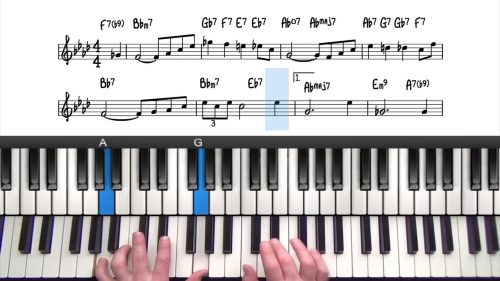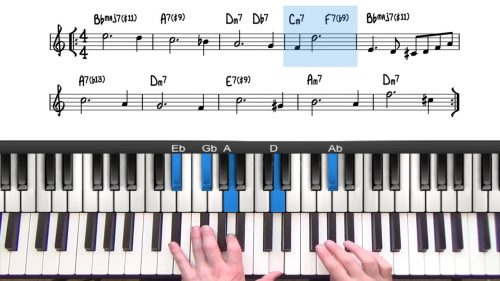All The Things You Are Tutorial
‘All The Things You Are’ is one of the most popular jazz standards of all time. It has been recorded by many different jazz musicians and so it’s definitely worth listening to as many versions as you can to get some creative ideas and inspiration.
Check out the Wikipedia page on ‘All The Things You Are’ where you can find a huge list of jazz musicians who have recorded the tune. This would be a good starting point to find a few versions you like so that you can incorporate their ideas into your arrangement.
Originally written in the key of Ab Major, the tune actually starts in F Minor and then modulates through C Major, G Major and E Major before returning back to the key of F Minor in the final section.
We’re going to start off with some 2 handed chord voicings and work through the whole tune at a slow-medium tempo. The second time through we will add more of an upbeat swing tempo and introduce some rhythmic elements to bring the tune to life.
In this lesson we also explore some new applications of quartal harmony and a number of different passing chords to achieve a sense of forward motion throughout the form.






Hallo. Nice video, but the transcription is not the same to the video ! Could you fix the sheet music (transcription) ?
Thanks.
Hey Ioannis, thanks for letting me know about this… I will correct it for you. Cheers, Hayden
Τhank you. I am looking forward.
Hello, I am still looking forward. :)
Hey Ioannis… yes I haven’t forgot about this! I will redo it for you as soon as possible :-) Cheers, Hayden
thank you.
At 3:31 do you mean to say ‘we also go to the 2 chord of A7 before hand’ or to the ‘2 chord of E7’? (Am doubtless missing something here.)
Hi Robert,
Apologies if this is not clear, E-7 and A7 is a 25 progression.
A clearer way to explain this is that we approach the A7 with its related ii-7 chord to create an additional 25 progression.
Whenever we have a V7 chord, we can approach it from its related ii-7 chord to create more interesting harmony.
E-7 –> A7 –> Dmaj7 would be a 251 in D Major.
In this case we are leading to Abmaj7, and the E-7 –> A7 is the tritone sub 25.
Does that make sense?
Cheers,
Hayden
Hello Heyden. Excellent tutorial! I feel reborn with these chords!! Please check Chord Changes & Reharms sheet, at 21. I think you mean F#m7(b5). Thanks again for your valuable teaching!
I agree it should be F#m7(b5).
hello
In the transcription measure 60, it seem omitting Bbm7 .